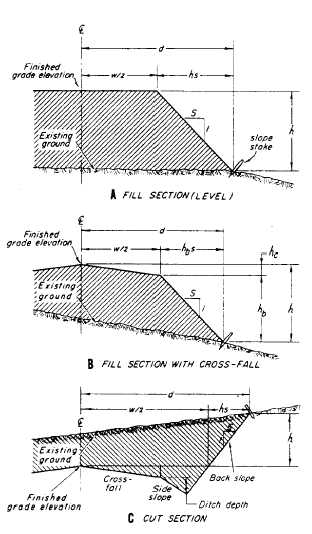Refer back to figure 14-31 and take a close
look at the position of the slope stakes. The
horizontal distance of a slope stake from the
center line varies, and to determine what it is, you
must know three things.
1. The width of the roadbed, including widths
of shoulders and ditches, if any
2. The side-slope ratio (expressed in units of
horizontal run in feet per foot of vertical rise or
fall)
3. The difference in elevation between the
grade for the road and the point on the natural
ground line where the slope stake will be set
In figure 14-37, view A, d is the horizontal
distance from the center line to the slope stake,
W/2 is the horizontal distance from the center line
to the top of the slope, h is the difference in
elevation between the finished grade and the
ground at the slope stake, ands is the slope ratio.
The product of h x s gives the run of the slope;
that is, the horizontal distance the slope covers.
The horizontal distance (d) of the slope stake from
the center line, then, equals the sum of W/2 plus
hs. For example, suppose that W/2 is 20 ft, h is
10 ft, and the bank is a 4:1 slope. Then
and
In practice, you may have to take other
factors into account, such as transverse slope or
the crossfall of the pavement (sometimes called
the crown), ditches, and so on. In figure 14-37,
view B, for example, there is a crossfall (h=) across
W/2 so that the run (horizontal distance covered)
of the bank (hbs) is the product of s x hb instead
of hs, as in figure 14-31, view A. The crossfall
is usually constant and may be obtained from the
typical design sect ion shown on the plans.
Figure 14-37, view C, shows a cut section in
which W/2 varies with crossfall, side slope, ditch
depth, and back slope. For example, assume that
the distance from the center line to the beginning
of the side slope is 20 ft, that the cross fall totals
1 ft, that ditch depth is 1.5 ft, and that both the
side slope and back slope ratios are 2:1. The
distance W/2, then,
comprises horizontal
segments as follows:
1. From the center line to the top of the slope
which is 20 ft
Figure 14-37.-Determining slope stake location (distance
from center line) for a proposed roadway.
2. Then to the ditch flow line, which equals
the product of slope ratio (2) times ditch depth
(1.5), or 3 ft
3. Then to the point on the back slope that
is level with the finished center line, which equals
slope ratio (2) times difference in elevation; that
is, crossfall plus ditch depth,
The total distance, W/2, then, is the sum of
SLOPE-STAKE PARTY PROCEDURE.—
Slope stakes are usually set with an engineer’s or
automatic level, a level rod, and a metallic or
nonmetallic tape. In rough terrain, a hand level
is generally used instead of an engineer’s level.
14-38


